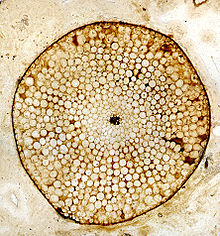Rhynia
| Rhynia | |||||||||||||
|---|---|---|---|---|---|---|---|---|---|---|---|---|---|
| Ocorrência: Devoniano | |||||||||||||
| Estado de conservação | |||||||||||||
| Extinta (fóssil) | |||||||||||||
| Classificação científica | |||||||||||||
| |||||||||||||
| Espécie-tipo | |||||||||||||
| †Rhynia gwynne-vaughanii | |||||||||||||
| Espécies | |||||||||||||
| |||||||||||||
Rhynia é um gênero Parafilético (Com somente uma espécie) de plantas vasculares do período Devoniano. A espécie Rhynia gwynne-vaughanii foi a geração esporófita[1] de uma planta terrestre embriofítica diplohaplôntica vascular, axial e de esporos livres do período Devoniano Inferior que tinha características anatômicas mais avançadas do que as das briófitas (musgos). Rhynia gwynne-vaughanii faz parte de um grupo irmão de todos os outros eutraqueófitos, que é um grupo que incluí as plantas vasculares modernas.
Descrição
[editar | editar código-fonte]Rhynia gwynne-vaughanii foi descrita pela primeira vez como uma nova espécie por Robert Kidston e William H. Lang em 1917.[2] A espécie é conhecida apenas a partir do Cherte de Rhynie em Aberdeenshire, na Escócia, onde cresceu nas proximidades de uma fonte termal rica em sílica. Rhynia era uma planta vascular, e cresceu em associação com outras plantas vasculares, como Asteroxylon mackei, um provável ancestral dos Licopódios modernos, e com Plantas Pré-vasculares como Aglaophyton major. Que é interpretada sendo um táxon basal das plantas vasculares verdadeiras.[3]

Pode ser que o Gênero Rhynia tenha tido ramos laterais decíduos, que foram usados para serem dispersados lateralmente acima do substrato.[4][5] talvez a planta possa ter tido populações clonais.
A evidência de uma geração gametófita do gênero Rhynia foi descrita como sendo na forma de tufos aglomerados de caules diminutos com apenas alguns milímetros de altura, com o nome sendo Remyophyton delicatum.[6] Como os da espécie Aglaophyton major.[7][8] e Nothia aphylla[9] os gametófitos do gênero Rhynia eram dioicos, Carregando gametângios machos e fêmeas em diferentes eixos. Um achado significativo é que os eixos dos gametófitos eram vasculares, ao contrário de quase todos os gametófitos das pteridófitas modernas, exceto os gametófitos de Psilotum.[10] normalmente, este gênero tinha cerca de 18 centímetros de altura e possuía células condutoras de água chamadas traqueídeos em seu caule, muito parecidos com as da maioria das plantas vivas. Raízes subterrâneas conectavam suas hastes acima do solo, essas hastes eram fotossintéticas.[11]
Taxonomia
[editar | editar código-fonte]Duas espécies do gênero Rhynia foram inicialmente descritas por R. Kidston e W. H. Lang que foram achadas no cherte de Rhynie, que foram: Rhynia gwynne-vaughnii em 1917,[2] e Rhynia major em 1920.[12] Rhynia gwynne-vaughanii foi nomeada por Kidston e Lang em homenagem do seu amigo e botânico David Thomas Gwynne-Vaughan.[2]
Ver também
[editar | editar código-fonte]Referências
- ↑ Edwards, D.S. (1980). «Evidence for the sporophytic status of the Lower Devonian plant Rhynia gwynne-vaughanii Kidston and Lang». Review of Palaeobotany and Palynology. 29: 177–188. doi:10.1016/0034-6667(80)90057-3
- ↑ a b c Kidston, R.; Lang, W.H. (1917). «Em plantas de arenito vermelho antigo mostrando a estrutura do leito de chert de Rhynie, Aberdeenshire. Parte I. Rhynia gwynne-vaughanii, Kidston e Lang». Transactions of the Royal Society of Edinburgh. 5 (3). pp. 761–784. doi:10.1017/s0080456800008991
- ↑ Edwards, D.S. (1986). «Aglaophyton major, a non-vascular land-plant from the Devonian Rhynie chert». Botanical Journal of the Linnean Society. 93 (2): 173–204. doi:10.1111/j.1095-8339.1986.tb01020.x
- ↑ Bateman, R.M.; Crane, P.R.; Dimichele, W.A.; Kenrick, P.R.; Rowe, N.P.; Speck, T.; Stein, W.E. (1998). «Early Evolution of Land Plants: Phylogeny, Physiology, and Ecology of the Primary Terrestrial Radiation». Annual Review of Ecology and Systematics. 29 (1): 263–292. doi:10.1146/annurev.ecolsys.29.1.263
- ↑ Edwards, D.S. (1980). «Evidence for the sporophyte status of the Lower Devonian plant Rhynia gwynne-vaughnii Kidston and Lang». Review of Palaeobotany and Palynology. 29: 177–188. doi:10.1016/0034-6667(80)90057-3
- ↑ H. Kerp, N.H. Trewin and H. Hass (2004) New gametophytes from the Early Devonian Rhynie chert. Transactions of the Royal Society of Edinburgh, Earth Sciences, 94, 411–428
- ↑ Remy, W.; Hass, H. (1996). «New information on gametophytes and sporophytes of Aglaophyton major and inferences about possible environmental adaptations». Review of Palaeobotany and Palynology. 90 (3–4): 175–193. doi:10.1016/0034-6667(95)00082-8
- ↑ Remy, W.; Remy, R (1980). «Lyonophyton rhyniensis n. gen. et nov. spec., ein Gametophyt aus dem Chert von Rhynie (Unterdevon,Schottland)». Argumenta Palaeobotanica. 6: 37–72
- ↑ Remy, W.; Hass, H. (1991b). «Kidstonophyton discoides nov. gen. nov. spec., ein Gametophyt aus dem Chert von Rhynie (Unterdevon, Schottland». Argumenta Palaeobotanica. 8: 29–45
- ↑ Holloway, J.E. (1939). «The gametophyte, embryo and young rhizome of Psilotum triquetrum Schwarz». Annals of Botany. 3 (2): 313–336. doi:10.1093/oxfordjournals.aob.a085063
- ↑ «Rhynia | fossil plant genus | Britannica». www.britannica.com (em inglês). Consultado em 7 de agosto de 2024
- ↑ Kidston, R.; Lang, W.H. (1920). «On Old Red Sandstone plants showing structure, from the Rhynie Chert Bed, Aberdeenshire. Part II. Additional notes on Rhynia gwynne-vaughani, Kidston and Lang; with descriptions of Rhynia major, n.sp. and Hornea lignieri, n.g., n.sp». Transactions of the Royal Society of Edinburgh. 52 (3): 603–627. doi:10.1017/s0080456800004488
Text is available under the CC BY-SA 4.0 license; additional terms may apply.
Images, videos and audio are available under their respective licenses.

